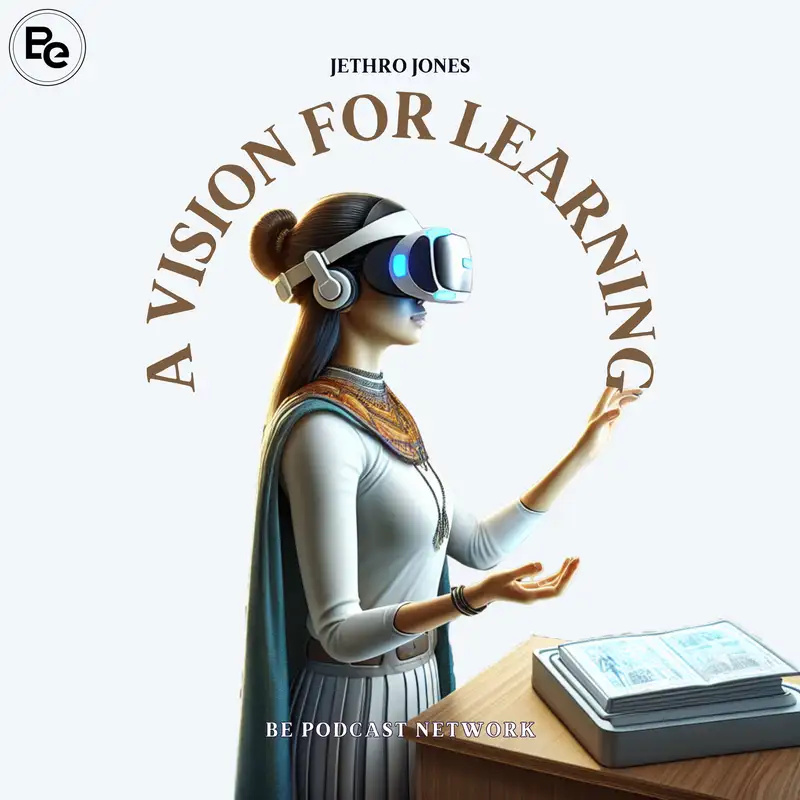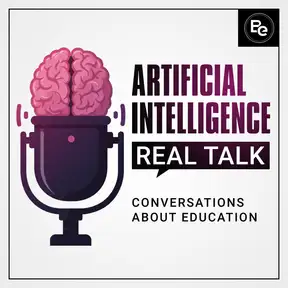Should I Buy the Apple Vision Pro for School Use?
Download MP3Jethro Jones: Welcome to
a Vision For Learning.
I am your host, Jethro Jones.
You can follow me on all
the socials at Jethro Jones.
And we are talking today
about the question, should I
buy this for use in school?
That's the real question.
That's what I'm here for.
I'm curious, can we use
this as a tool in school?
Is it too expensive?
If not every kid can have one.
Is it even worth it?
These are the things that I'm thinking
about, so I've been using it since it
came out last week, and if you haven't
heard my episode about using it for
productivity, I suggest you go check
that out at a vision for learning.
It's definitely useful for productivity
and some things are just incredible on it.
For example, reading is really good.
I really enjoy reading.
That's not what we're here to talk about.
Go listen to that
episode and check it out.
Let's talk about should we
use it for school, will it
work for using it for school?
So the first thing is that I,
apple designed a few things
right from the beginning that
I think really matter a lot.
Number one.
They created a guest mode
that is very easy to access.
That is one of the defaults.
They know the other people
are gonna want to try this.
And the guest mode allows you
to share it with someone else
and let them experience it.
And when you go into guest mode, what is
an option to let someone else use it, and
it asks you a couple of different things.
It says, do you want to allow all
apps or only the opened apps?
And so it asks for that first, and then
it says, do you want to view mirroring?
Which means do you want to project
what the person sees inside there to
another display, either another, a
computer display or an Apple TV display.
And by computer display, do
you want to mirror it on.
Your Mac computer, that's
what it's set up as.
And I'm guessing it'll probably
work with any airplay compatible
device that's been, that's my guess.
So that is set up from the beginning.
The other thing is, one of the tools
that we've used in education for a long
time to give students access to Apple
devices is what's called guided access.
And guided access is an accessibility
tool that keeps the device in a specific
app, rather than allowing the user to
go into any app that they want to go to.
And this is a powerful thing
because what it does is
guided access allows you to say,
this is the specific app I want
somebody to be able to use and I
don't want them to use anything else.
So you set it up being
say, start guided access.
Here's a passcode.
When somebody wants to get out of it,
they they have to use a passcode that is
separate from your optic id, so they don't
have to know your password to log in.
You set up a separate passcode for.
Them to be able to get out of that,
which you could tell them if you felt
like you needed to or you could not
tell them so that they can't exit out.
Now, if you want to have students be just
focused on one particular app and not
use anything else, then you can do that.
Here's a challenge with that.
Once they take it off, as far as
I can tell, you have to put it
back on for you and recalibrate
it and get it set up, for them.
So that can be a little bit challenging
now, because this uses your fingers
as the input device and your
eye tracking it has to walk them
through that setup every time.
A new user puts it on.
So that could be a little bit challenging,
could lengthen the time to do it, but
it's also a good opportunity to have that
experience of figuring out how everything
works, because once you put your hands
up and it scans your hands, and once you
tap the little dots with your eyes, then.
Then you're good to go and you
know how to use the device.
So that aspect is pretty cool.
What I also like is that because
it's using what you have, there's no
controllers that you have to try to figure
out how to manipulate to get 'em to work.
and it just, it works
with what you have and.
for my oldest daughter who has
Down Syndrome, she was able to
figure it out really quickly.
Now, on that, let me talk about a little
side thing here that can be challenging.
When you give guided access or you
give guest access and somebody's using
it, if you turn on mirroring the.
Tool to invoke that mirroring heads
up display is pretty much always on
the screen and it's always right at
the corner of your eyes, and so it's
very easy to tap that instead of
tapping the thing that you want to tap.
And so that is really challenging
for anybody who's using it, who
doesn't know what that is there
for and what its purpose is.
it just gets in the way too much and makes
it difficult for someone who's new to the
device and it can be quite frustrating.
So that is, is the big drawback.
Now, secondly, apple says this device
is designed for people over 13 and.
There may be other reasons for that, but
one very clear, obvious reason is that
it is not designed for little heads.
when my 12-year-old daughter wanted to
try it, I let her try it and she had
to hold it up underneath the Vision
Pro so that she could keep it on her
face, and keep her eyes lined up.
That's not a good experience.
So what we did is we put
a beanie on her head.
And then that worked out just fine.
And she was able to use it without
holding it up with her hands,
which also block the IR blasters.
They block the cameras underneath and
that look at your hands and all that,
and then one hand is busy holding it
up, which makes it difficult as well.
So that was the second piece.
First piece was guest
mode and guided access.
Second piece was, this is
not designed for little kids.
Third piece is that this is a sturdy
device, but it's probably quite delicate.
There are a couple times that my kids
have been using it and I've been a little
nervous about them moving around with it.
they can get pretty into the immersive
experiences that can make it.
A little bit nerve wracking, so
just be thoughtful about that.
Here's the other piece.
Apple suggests that you put the
cover over the glass on the front.
There is a lot of glass on this
thing, and that's something
that you've gotta be aware of.
And as it relates to kids
and glass, we know that those
things do not go well together.
So I would say probably you
wanna use some extreme caution
if you're thinking about that.
The other part of it being sturdy, but
probably delicate is that there is glass
and the screens that your eyes are
looking at are rumored to cost a thousand
dollars each, which is pretty expensive.
The other thing to really be aware of
with this is the band that attaches to the
headset comes off exceptionally easily.
It is really easy for that to fall,
and it feels natural to want to
carry it by that strap, but doing so
would probably lead to a dropping and
falling very easily at the Apple store.
When I bought it, they showed
me how to put it on by.
Putting my thumb where the nose
goes and my two fingers above on
the top and putting it on like that.
You really do not wanna hold it by the
strap because it comes apart so easily.
That is a major feature when you're
trying to switch straps, but definitely
not how you want to be carrying it.
'cause if you carry it like
that and then the it falls.
It's gonna land right on the glass
and that is surely going to break it.
even if you have the protective cover on,
I think the protective cover is sturdy,
but I don't know that it's that sturdy.
The thing that I'm not sure about,
and I have a, an ophthalmologist who's
gonna come on the show and we're gonna
talk about this, what I've noticed
in having these screens just inches
away from my eyes for hours at a time.
I have not had the same reaction
that I've had staring at my
phone for hours at a time.
There are a couple of
things that are different.
Number one, I'm sitting up straighter.
Number two, I am focused more on my
posture and how I'm sitting because
I have this big thing on my head and
I need to keep it where it should be.
and so that piece, if I'm,
I made a sudden movement.
The other day when I was using it, and
I definitely felt it because I was not
prepared to make that kind of a movement.
And I felt it in my neck and in my
back and it didn't hurt me, but I did
feel it and I thought, okay, I better
pay attention to how I'm moving.
And so that aspect you want to
be thoughtful about as well.
So back to the I situation.
I've had this on my face for
hours at a time, and I have not.
I have not felt the eye fatigue that
I have with using a computer screen
or an iPad, in a similar manner.
And I'm very curious why that is.
And so hopefully when I have an
ophthalmologist on the show here
in a little while, I'll be able
to get some insight about that.
And I think that is just
a really interesting.
Idea to think about, is this going to
cause the same sort of eye strain or not?
We don't know yet.
certainly there's going to be some
research done and people are gonna
be curious about that, but there
is a company that is actually
using virtual reality to train I
don't remember the exact word, but.
The thing that gives you a lazy eye.
They're using virtual reality to train
that, using headsets like this to make
it so that kids, don't have that lazy
eye problem, which is really fascinating
because instead of wearing an eye
patch, you can watch a show in virtual
reality goggles for an hour a day,
and that takes care of your lazy eye.
that's pretty amazing, right?
Okay, let's talk about the cost.
Yes, it's expensive.
$3,500 for a device to put on kids' heads
could be considered quite expensive.
And if you're just looking for some
virtual reality type thing, there are
a lot of cheaper solutions out there
that probably justify it a lot more.
I think one of the real advantages
here, I also talked about this in my
productivity episode, from last time.
One of the real advantages is the apple
ecosystem of apps that already exist,
and there's already tons of apps that are
out there, that if you're using them on
iPads, you could likely use them in much
the same way on the Apple Vision Pro.
The real benefit, I think will be
those apps designed specifically
for the Apple Vision Pro that I am
excited to see what is out there.
On Transformative principle, I had, Vinje
on who talked about Florio, how they use
this virtual reality, had kids with autism
interact better with other people and.
Those kinds of use cases are incredibly
powerful because they really get
at things that are so difficult for
us to teach if we are not able to
go be in that specific situation.
And they open the doors for, especially
people with disabilities where things
are not usually designed for them.
And this is a way that you can
custom design experiences for them.
So if you already are using a lot of apps.
With your students, you will likely
be able to find a lot of apps that
work for the Vision Pro right out of
the box, which I think is pretty cool.
So should you get it for your school?
I don't know.
that's up to you decide how old
are the kids you're working with,
how, capable will they be of.
Managing and dealing with the expensive
device that's gonna be on their head.
How comfortable is it going to be and
what kinds of things can you do, with it?
So let's talk for example, about
this app called, jig Space.
This is the one that you've
probably seen that has an F1
card that you can blow apart and
check out and see all this stuff.
But there's a lot of
other things with it that.
Are really cool and one of them is
replacing solenoids on some sort of,
equipment that I don't even understand
what it's there for, but it walks you
through the whole process of setting that
up and looking at it in three dimensions
and being able to zoom in really big.
Being able to view it in all these
different ways, and it's just really
amazing and that's the kind of
thing that you want to be able to
do to help your students see what is
possible and what they can do with it.
It really is.
A powerful thing that I think
has a potential to really
change a lot of education.
Now, like I've said before, this is
not the first virtual reality headset
that has been introduced, but I
think the difference is the ecosystem
that exists, that Apple already has
things that are already out there
that you can start bringing them in.
Right away and start experiencing them.
There is a lot of cool,
neat, unique things.
In my interview with Shannon, Putman.
Last week we talked about this
idea of intrinsic versus extrinsic
motivation and how you could use this
as a way to help motivate kids to get
things done and do different things.
And what is cool is that there are, a
bunch of apps that already are created and
designed for the Apple Vision Pro that.
Could basically be rewards.
I think one app in particular that
you might like, especially in a school
setting, is an app called Illustrated,
and this is an Apple arcade game, and
it's called a game because it's puzzles.
But when you go into the app, what
you do is you go into a museum.
the Van Gogh Museum, for example, and
you look at all these different pictures
by Van Gogh and then you put a puzzle
piece, you put the puzzles together to
recreate the pictures and each picture
has a story behind it, has descriptions
about what it is so that this really is.
A learning opportunity for your
students, and I think that this is
really powerful to really experience
these masterpieces and to learn
about the stories behind them.
And that can be fun in and of itself.,
The really cool thing is that so much more
is going to come from people's experiences
designing and developing things
specifically for the Apple Vision Pro,
and this is just going to explode now that
people have it in their hands and there's
going to be so many more different unique
ways of doing things that I'm really
looking forward to what people create.
If you are using it in
schools, reach out to me.
Let me know that you're doing it and
I'd love to chat with you more about it.
So there you have it.
Those are my thoughts.
Two or three days in about whether
or not you could get the Apple
Vision Pro for your school.
If you have one, reach out to me.
I'd love to talk to you and
love to hear how you're using
it in your school setting.
And what that looks like and
what your experience is with it.
So far, I'm at Jethro Jones on all the
social networks, and I would love to have
you come on the show and talk about what
you're doing, and if you're using some
cool apps , please share those with me.
I'd love to get in and play with those
as well and see how they work or don't.
And thanks again for listening
to a Vision for learning.
Please share this with your friends.
Go and leave a review on
Apple Podcasts or Spotify.
Make sure it's five stars and
only have nice things to say.
Appreciate you and we'll see you
next time on a vision for learning.
Creators and Guests


